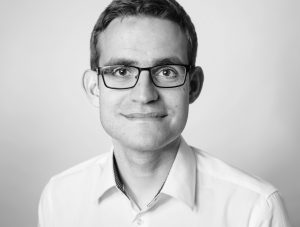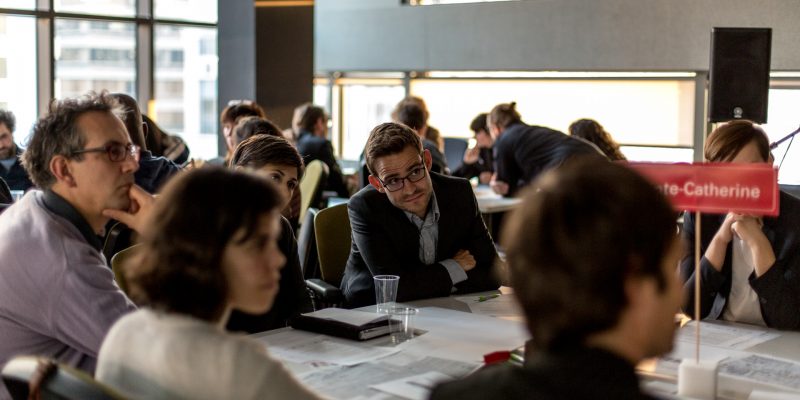This is a guest post by Dr Jochen Steffens, Postdoctoral Researcher from the Technical University of Berlin, Germany.
I was pleased to accept an invitation from Sounds in the City to speak at their workshop on the potential of water sounds to improve soundscape quality in urban environments. In particular, I was excited to interact with practitioners who might have the potential and creativity to immediately realize some of my ideas based on my research with water features in the urban context.

© Sounds in the City
My talk began with a short introduction on the history of water fountains: formerly used to provide fresh drinking and bathing water to residents, their importance and generally central locations meant that they increasingly became used for decoration and to honor their builders. Nowadays, water features are almost exclusively utilized for entertainment purposes.
They come in various forms, for example as simple water jets installed in asphalt, which invite kids to walk through them; they also can constitute futuristic art objects or amusing optical illusions. One interesting illusion is the “Magic Tap,” found in a few parks in Spain, which appears to float in midair with an unknown but endless water supply. Water features fulfill different functions in the context of urban spaces, like increasing visual pleasantness or encouraging lingering, and their positive contribution to soundscape pleasantness is largely undisputed. Water’s sound-related functions also include constituting a “soundmark,” which provides identification of a place and creates a memory of what it sounds like. However, its use in supporting good soundscapes on purpose has been limited to a few cases in the whole world.
Before I started talking about water, we had to talk about some psychoacoustics: how louder sounds, due to physiological processes in the inner ear, might make other (less loud) sounds inaudible (“energetic masking”). Or how our attention to sounds with important information can make us inadvertently ignore irrelevant sound (“informational masking”). Then came the acoustics.
To demonstrate that water features may sound completely different, there were examples of different flow rates, falling heights, and the surface on which the water falls. This work came straight from research colleagues in the field had conducted years ago in a laboratory. These studies led to graphs that demonstrated in detail how these three parameters affect the sound level and frequency spectrum and thus can be considered crucial parameters in the acoustical design of water features.
From here, we could talk about recommendations for cities: for example, in case of waterfalls, low frequencies for energetic masking can simply be generated by increasing the flow rate – this would be good for masking traffic noise. One can also simply let the water fall on concrete, stones, or boulders – this would be good for creating a fresh sound dominated by high frequencies.
To illustrate how water features sound in combination with (annoying) road traffic noise, I played some sound examples and asked the workshop participants how they liked it and whether the water sounds were able to mask the traffic noise. The result was that sounds perceived as most pleasant and calm (e.g. cascades) when played alone were unable to mask the traffic noise. Thus, we obviously can only use such calm sounds as an acoustic design feature in very quiet environments. In contrast, in case of a noisy street nearby, most people prefer “fresh” (sharp) water sounds, such as streams and fountains with multiple jets, since they have the potential to make the road traffic inaudible, at least partially.

Once we had established some of the core features of our fountains, we could talk numbers. Based on what was already mentioned in the scientific literature, I presented a rule of thumb: road traffic sounds should not be more than 3dB louder than the water sounds they are trying to (energetically) mask. If the aim is also to achieve some informational masking, i.e. simply distracting people from noise, then a water feature should be also attention-grabbing with regard to both its acoustical and visual aspects.
In the end of my talk, I presented a few case studies where fountains have successfully been implemented in urban environments, e.g. in the Sheffield “waterscape.” Another example from a study I did with my colleagues showed that water features might also improve soundscape quality in domestic environments (e.g. garden).
Furthermore, I demonstrated how the effect of water sounds can be investigated in the planning state of a public space, for example by means of virtual reality techniques. This means, that we can see and hear the water feature in a specific space before being actually built. At the end, I stressed that water features are a promising tool in soundscape design and can be used in many contexts. Finally, in order to achieve a great design of water features, I encouraged acousticians, architects, and visual designers to work together. Luckily, we had a chance to do just that in the afternoon.

© Johannes
I experienced the resonance of the audience to be very positive. The interesting questions and discussions during the lunch break made me realize that I managed to sensitize the workshop participants for the soundscape approach and inspired them with some new ideas to solve noise problems. Especially the breakout session made me smile (even though it does not look like it in the photo) when I noticed that in all of the three project groups, water features were proposed as one of the crucial design elements to improve Montreal’s soundscape. If I come back in a couple of years and see a few more water features in the streets of Montreal, I would be really happy to believe that I really made a contribution to the development of this beautiful city.
Read more:
Galbrun, L. & Ali, T. T. (2013). Acoustical and perceptual assessment of water sounds and their use over road traffic noise. The Journal of the Acoustical Society of America, 133 (1), 227–237.
Jeon, J. Y., Lee, P. J., You, J. & Kang, J. (2012). Acoustical characteristics of water sounds for soundscape enhancement in urban open spaces. The Journal of the Acoustical Society of America, 131 (3), 2101–2109.
Skoda, S., Steffens, J. & Becker-Schweitzer, J. 2014, January. Road traffic noise annoyance in domestic environments can be reduced by water sounds. In Proceedings of Forum Acusticum (Krakow).
About Dr Jochen Steffens
 Jochen Steffens is a Berlin-based researcher with a PhD in psychoacoustics and a formal background in audio and video engineering and psychology. He is interested in how we listen to sound and music, how we can predict and understand music listening behavior, and how listening affects our actions and the perception of ourselves and the environment. Currently, he is working as a Research Associate and Lecturer in the Audio Communication Group at the Technical University of Berlin.
Jochen Steffens is a Berlin-based researcher with a PhD in psychoacoustics and a formal background in audio and video engineering and psychology. He is interested in how we listen to sound and music, how we can predict and understand music listening behavior, and how listening affects our actions and the perception of ourselves and the environment. Currently, he is working as a Research Associate and Lecturer in the Audio Communication Group at the Technical University of Berlin.
